|
September 6, 2021 --
Onions for all Occasions
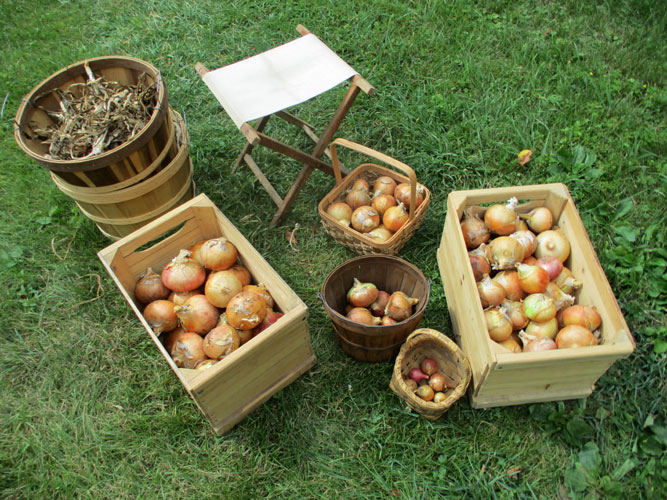 We eat quite a lot of onions - small ones in luncheon salads, larger
ones in a variety of dinner dishes, tiny ones to save and plant next
year as onion sets, any size diced up with sweet peppers and fermented
into a delicious relish. My seed is an open-pollinated mix that I've
been growing and saving for decades, aiming for that sweet spot of
medium size that is just right for one meal. And some years I get a lot
that size, some years more smalls, and some years more large. My onions
are very independent. We eat quite a lot of onions - small ones in luncheon salads, larger
ones in a variety of dinner dishes, tiny ones to save and plant next
year as onion sets, any size diced up with sweet peppers and fermented
into a delicious relish. My seed is an open-pollinated mix that I've
been growing and saving for decades, aiming for that sweet spot of
medium size that is just right for one meal. And some years I get a lot
that size, some years more smalls, and some years more large. My onions
are very independent.
And this year they decided to make great use of this (rare? or now
common?) hot summer and go for large, as in three-meals worth sized (in
the left crate). Even the mediums are on the hefty size. Like most
things in the garden they matured early so were harvested 2-3 weeks ago.
So they've been curing under cover, waiting for that perfect nice day
when it felt great to sit outside in the sun and clean the beautiful
bulbs for storage. And this was the day. It was a very good harvest, and
much appreciated.
Onions are
truly a year round crop for me. One of the last to be planted outside in the
fall they are also one of the first to be planted inside in the spring. And most
years they are fresh for the eating all twelve months, if one allows stored
roots as being fresh. Once planted they demand little in the way of fussing
which makes them a little too easy to overlook when extra attention is needed.
But they are hardy souls and usually pull through in spite of the gardener or
the weather.
This doesn’t mean one can just ignore them and get a good crop. They have their
requirements and preferences and are known to withhold their favors if the
basics aren’t met. But in general they are easy to grow and harvest, and seldom
is a day that they aren’t a part of at least one meal for us, usually two.
Considering that so many of the inhabitants of my garden tend to excessive
complaints about the cold and short season, the hardy onions are a welcome
companion.
Onions come in many styles, flavors and habits and it is this diversity that
allows “year-round” designation for me. If you add in other Alliums such as
leeks, scallions, shallots, garlic and chives you can have a large choice and a
large garden of wonderfully (for those who are fond of that flavor) tasty
additions for the pot and table. I grow 'regular' storage onions, potato onions,
green onions, garlic, chives and 'for seed' onions. The regular bulb onions are
my main crop, used in so many different ways. But success all starts with...
SOIL -- My garden soil is sandy loam built up over the years by the plants that
grow there and hay mulch that is added, with a little compost from the bin here
and there, maybe some wood ashes. Plus whatever is contributed by the snow and
rain and wind (which I think is more than is usually given credit for). It grows
good crops including the onions.
WEEDS -- There are some vegetables that can handle weedy companions and some
that can’t. Onions are staunch individualists (at least mine are). They don’t
demand a lot of space but what they have they prefer to inhabit it by
themselves. One of my first learn-by-experience garden lessons was with a weedy
patch of onions (actually, the entire garden was full of weeds that year). These
were the generic purchased commercial yellow onion sets which are generally
hardy and able to overcome many gardener errors. And they did grow. And I did
get around to weeding the plot eventually, maybe mid-summer. The onions weren’t
real happy but they came through and made a reasonable crop but the bulbs were
small. I was happy to have any at all. And when I cut open one of those nicely
matured and cured bulbs I discovered that they contained all of the fire that is
usually spread out throughout a much larger bulb area. I wiped my eyes and was
still happy to have them, but no nibbling raw pieces that year. Whew! Maybe it
was the hot summer not the weeds but I vowed not to not crowd the onions in the
future. And though I never had such a badly overgrown onion patch again,
subsequent years have confirmed that they like their space and resent intruders,
whether it be encroaching weeds, other garden plants or other onions.
PLANTING -- So it is with spacing of the plants. Mine seem to like to be 5”
apart. They could be a bit more or less but my five foot long “planting dibble”
has dowels set every 5” and that spacing works well. Since I plant in wide rows
(permanent beds in my case) that spacing is both along and across the beds, and
is used for all my main crop onions as well as garlic. When to plant depends on
what I want and what I’m planting (seed, sets, plants) but most onions are
planted in early spring for fall harvest. Onions like the sun so are planted in
a sunny bed.
REGULAR ONIONS -- Which in my case means onions that grow from seed. My onion
seed is a cross of various short season open pollinated (OP) storage onions
which have been available from the independent seedmen over the years. We aren’t
in the best onion from seed and onion seed growing area; they generally prefer a
longer season. I’ve experimented with many varieties, hybrid and OP. My
requirements limited my selection and what got to continue. I wanted onions that
were (1) good keepers, (2) would grow bulbs of a reasonable size without too
many thicknecks in a normal growing season, and (3) would grow and set viable
seed the second year. It turned out the yellow onion varieties were the best
though there's still a few reds in my mix. I’ve been growing, crossing (or
rather allowing to cross) and selecting for thirty years so my seed is pretty
well adapted now to our climate and my garden.
But there are good onions to be had from the seedmen. If you aren’t going to
grow your own seed it doesn’t matter if you grow hybrid or open-pollinated seed.
Fedco Seeds offers a good selection of varieties for the short season gardener
as do many other of the independent seed companies. Onion seed is one of the few
that doesn’t remain viable for very long. It depends on the quality of the seed
but I figure three years, four years is pushing it, seldom will they germinate
after that. It’s easy to do a germination test of a couple dozen seeds ahead of
time if in doubt. But I simply plant and make note how each year’s seed (or each
variety) germinates when I plant them, then I know for the next year. If the
germination is poor I toss the seed, if it’s just OK but not “very good” I plant
thicker the next (probably last) year. The seed doesn’t just completely give out
suddenly one year so it’s not an all or nothing scene, but it does go downhill
after a few years.
DIRECT SPRING SEEDING -- Even the earliest maturing onion seed will seldom make
a good crop when planted directly in my garden in early spring but that doesn’t
keep me from trying. They grow fine for salad onions when young and certainly
edible later even if they don’t get large. If I have extra seed and extra space,
and I remember (they do have to be planted early), I might plant a small plot of
seed. Sometimes Nature treats me and the onions well and I get a reasonably good
crop, though they are always smaller bulbs than those from plants or sets. I
plant in rows about 5” apart, thinning within the row to 3-5” apart.
DIRECT SEEDING OVERWINTERED -- This is experimental for me but I’ve planted seed
in late spring/early summer and left them to grow to overwinter. Success varies
depending on the weather, but it’s easy and if they make it so much the better.
A light mulch in the fall may help them through cold times when the snow comes
late or is sparse. But too much mulch makes for too tender plants which are
susceptible to damage by spring frosts and freezes. They start growing very
early in the spring so pull extra mulch away early. If temps plummet throw the
mulch back over them. In years of good snow, mulch wouldn’t be so important and
they seem to come through hardier. But it’s hard to guess in the fall how much
snow we’ll have. Before they get too large in the spring I transplant them out
to 5”. Or you could just thin them where they are to that spacing. This is
easier than starting the plants inside but not as reliable for our zone. These
plants are more likely to want to set a seed head and to form double bulbs but
they’re great for early fresh eating and the seed heads are easily nipped off.
They mature earlier than the greenhouse started plants which is nice for summer
harvest.
Of course, many times onions are overwintered successfully in the garden on
their own without any help or hindrance from me. Small onions in the main crop
that are overlooked or ignored at harvest time often grow up in the spring. I
used to “weed” them out, now I let them grow or transplant them to a better
spot, using them as an early green onion or larger bulb onion later as above.
They are a reminder that I’m apt to make gardening more complicated and
difficult than it needs to be!
PLANTS -- My main crop is started early in the greenhouse. In March when the
weather warms a bit, I get that winter’s-winding-down feel, it’s maple sap time,
and I just feel like planting something. It’s time to start the onions and
peppers. I plant the seed not too thickly in flats, rows an inch or two apart,
keeping the different years (or varieties) separate. They usually start inside
near the woodstove until they’re up then they move out to the greenhouse.
They’re hardy and don’t mind the cool room. The biggest chore is to thin them to
a reasonable spacing as they grow, a half inch apart would be good, or so I keep
telling myself. They do MUCH BETTER when not crowded. But they look so small
it’s hard to convince myself that they do indeed grow and want their space. I
also keep the tops trimmed down to maybe four inches. It makes for sturdier
plants at transplanting time and less of a tangle. Overall onions are one of my
least fussy plants in the greenhouse.
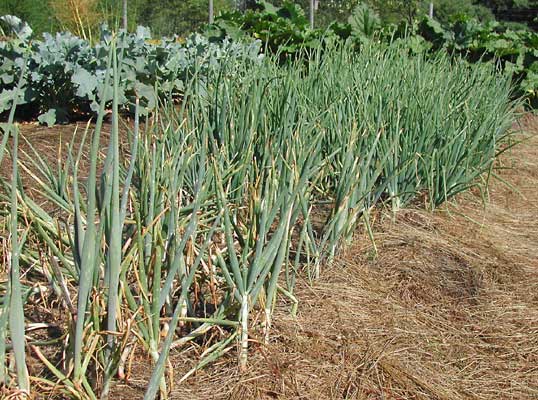 They
simply grow and when the weather has settled some outside they’re ready to go.
Because we often get early spring dips into the teens I’ve learned to be patient
and not set the onions out too early, usually end of May/first of June. Once
they’re established they’re quite hardy but new transplants are somewhat tender,
and hard to cover. I like to wait for cloudy days to set them out since they
usually don’t get any extra protection while settling in. A kitchen fork makes a
good tool to loosen the plants from the flat and the roots from each other.
Sometimes I hoe a trench and set the plants in about 5” apart, pulling the dirt
back around them as I go. Sometimes I use my long dibble to set the spacing and
make small holes, using my fingers or fork to make a larger hole when needed to
put the little plant in. Then a good watering if no rain is imminent and they’re
done. They
simply grow and when the weather has settled some outside they’re ready to go.
Because we often get early spring dips into the teens I’ve learned to be patient
and not set the onions out too early, usually end of May/first of June. Once
they’re established they’re quite hardy but new transplants are somewhat tender,
and hard to cover. I like to wait for cloudy days to set them out since they
usually don’t get any extra protection while settling in. A kitchen fork makes a
good tool to loosen the plants from the flat and the roots from each other.
Sometimes I hoe a trench and set the plants in about 5” apart, pulling the dirt
back around them as I go. Sometimes I use my long dibble to set the spacing and
make small holes, using my fingers or fork to make a larger hole when needed to
put the little plant in. Then a good watering if no rain is imminent and they’re
done.
That’s it until they’ve grown sturdy and the weather has warmed up. Then they
get mulched with sawdust or planer shavings or dried grass clippings. I have
used hay but it’s pretty fussy getting it in there without damaging the onion
tops. Earlier when the weather is still cold the bare ground helps keep the
plants warm and protected from frosts. Later the mulch keeps the soil cool and
moist, as well as discouraging weeds.
FRESH Green
onions can be pulled anytime throughout the growing season, for the greens or
the bulbs or both, chopped into salads or offered for direct munching, or cut up
(or not) for the cookpot. Any of the onions in my garden are fair game for this.
Early in the season it’s whoever gets large enough first, later it’s the
smallest and tenderest fry (for fresh eating) which aren’t going to make a
storage bulb anyway. One can grow bunching onions just for this purpose, and I
do sometimes, the kind that multiply and don’t make large bulbs. But they seem
to get out of hand with the multiplying for me (we just don’t need that many
green onions) and it's mostly easier to simply pull appropriate green onions out
of my regular crops. Through the summer I pull any “thicknecks” when they’ve
sized up enough to be useful since they aren’t going to cure and store as well
as bulbs with thinner necks. And any that are growing a seed head (break that
off) since they also aren't going to store well.
That’s about it until harvest time. My onions are wonderfully independent. This
is my main storage crop. They are usually ready for harvest in September and
keep until we run out, often in June or early July, providing good eating along
the way. Since most of my cooked meals start with “saute onions and garlic ...”
I like to have a bushel or more put up in the fall. It’s an unhappy and
thankfully rare year that I have a such a poor crop that we have to buy onions.
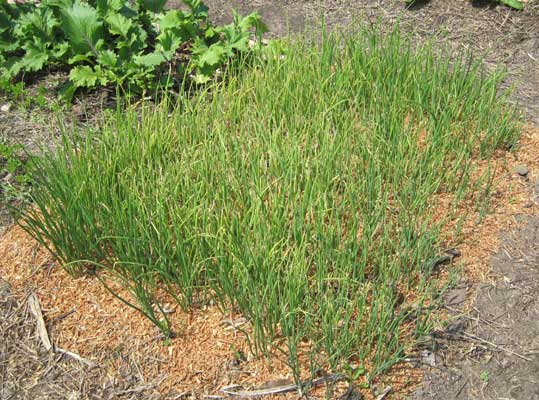 ONION
SETS -- Onion sets are readily available in the spring in our area -- paper bags
of usually yellow sets of variable quality and unknown parentage and source, but
probably all the same. If you sort through and toss half, the rest will make a
pretty good crop of reasonable storage onions. You can often get better quality
ones from a good seed company if you remember to order them early enough.
They’re easy to plant, just push them in where you want them to grow, root side
down. But I don’t like to be so limited, I want to know where my plants come
from, who they are, and I want diversity. Plus I like to do my own. So, in
addition to all the other onion methods I use, I like to grow my own sets. It’s
not hard if you plant them at the right time for the weather conditions that
year. The weather is a pretty big variable but if all goes well you can have
some really nice and easy to plant sets, then other years not so. So I still
depend on my seed crop, but sets are easier. ONION
SETS -- Onion sets are readily available in the spring in our area -- paper bags
of usually yellow sets of variable quality and unknown parentage and source, but
probably all the same. If you sort through and toss half, the rest will make a
pretty good crop of reasonable storage onions. You can often get better quality
ones from a good seed company if you remember to order them early enough.
They’re easy to plant, just push them in where you want them to grow, root side
down. But I don’t like to be so limited, I want to know where my plants come
from, who they are, and I want diversity. Plus I like to do my own. So, in
addition to all the other onion methods I use, I like to grow my own sets. It’s
not hard if you plant them at the right time for the weather conditions that
year. The weather is a pretty big variable but if all goes well you can have
some really nice and easy to plant sets, then other years not so. So I still
depend on my seed crop, but sets are easier.
Planting for onion sets is pretty much the same as planting seed for fall
onions, but plant them later, in early to mid June, thicker and in wide bands
instead of a single row. Best to thin them to maybe a half inch apart. They want
some room to grow but keeping them close keeps the bulbs small for nice sized
sets. Too close and they’ll not be large enough. Little thinnings are tossed
aside but larger ones are used for green onions for salads. Often plants on the
edges will get too large for sets but they'll be just fine for use in the
kitchen where you might use shallots.
Manage them
like regular onions. When the tops start drying down, pull and cure, sorting
through and tossing the very smallest specimens. A wide variety of sizes will
grow onions the next year but as they get larger they are more apt to send up a
seed stalk, and the smallest will have a harder time getting going and making a
good sized bulb, plus they don’t keep as well. I go for about a half inch for
sets; larger ones we eat. I store them in a small mesh bag in the pantry. In the
spring plant them as you would any purchased sets.
I also save the smallest onions from my regular storage crop to plant as “sets”
the next spring, even if they’re an inch or more across. These will grow fast
and likely set a seed head early but nip this off and they’ll go on to make a
good sized onion for summer cooking, or an early green onion for salads..
HARVESTING -
STORAGE -- Bulbs to be stored for months for off-season use need to be well
cured and treated well. When the tops have yellowed and started to dry I pull
the plants. If you wait too long, when the leaves are well along in drying,
you’ll have to lift them with a trowel since the tops will pull off when you
pull. And if you wait too, too long and the tops are all dried they’re hard to
see. Better to get them at the right time, when the green is mostly gone but
before they’re dead and drying on their own.
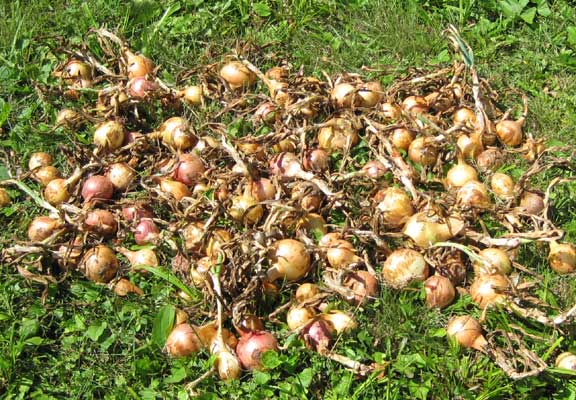 I
harvest on a sunny day when the soil isn’t too wet. Pull the onions and lay them
out along the plot in the sun for initial drying and for sorting. Then move them
out to a convenient spot in the shade for curing. My favorite is on the plywood
floor of our woodshed (in summer it's also a storage shed so space is limited).
Most years late summer/early fall is nice enough weather that this works fine. I
might also spread the onions out on the lawn somewhere dry and out of the way,
taking them under cover at night (when damp settles in or frost threatens),
spreading them out again when it’s nice. Basically you want an airy, dry spot
out of hot sun for several or more weeks. I
harvest on a sunny day when the soil isn’t too wet. Pull the onions and lay them
out along the plot in the sun for initial drying and for sorting. Then move them
out to a convenient spot in the shade for curing. My favorite is on the plywood
floor of our woodshed (in summer it's also a storage shed so space is limited).
Most years late summer/early fall is nice enough weather that this works fine. I
might also spread the onions out on the lawn somewhere dry and out of the way,
taking them under cover at night (when damp settles in or frost threatens),
spreading them out again when it’s nice. Basically you want an airy, dry spot
out of hot sun for several or more weeks.
Early on when
the tops are still a bulky presence a wheelbarrow works well for moving onions
around. Later when the tops are drying up (not so much mass) then baskets are
nice. Any garden dirt that came along with the bulbs falls off naturally and
easily in the handling. Of course, you want to handle your bulbs with reasonable
care if you want them to store well.
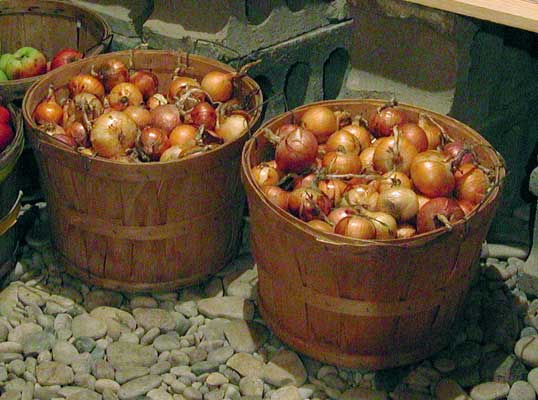 After
some time of this in and out the tops are all dried and mostly crumpled off, the
roots are dried and easy to break or snip off, the skins are nice and crinkly
dry. Sometimes I just rub off whatever tops are left and whatever roots want to
go and not worry about the rest. Often I sit down with shears and snip off the
dried tops and roots, gently rubbing off excess skins and setting them happily
in wooden crates or half-bushel baskets. It’s a pleasant task and one I enjoy.
Any thicknecks or bulbs not cured yet are put in a separate basket or bucket to
be eaten first. Though those thicknecks will last quite awhile, stored in a
bucket in the rootcellar. So if you have a year of many thicknecks (some years
are like that) don't fret too much. Save your best keepers for later and enjoy
the thicknecks earlier. After
some time of this in and out the tops are all dried and mostly crumpled off, the
roots are dried and easy to break or snip off, the skins are nice and crinkly
dry. Sometimes I just rub off whatever tops are left and whatever roots want to
go and not worry about the rest. Often I sit down with shears and snip off the
dried tops and roots, gently rubbing off excess skins and setting them happily
in wooden crates or half-bushel baskets. It’s a pleasant task and one I enjoy.
Any thicknecks or bulbs not cured yet are put in a separate basket or bucket to
be eaten first. Though those thicknecks will last quite awhile, stored in a
bucket in the rootcellar. So if you have a year of many thicknecks (some years
are like that) don't fret too much. Save your best keepers for later and enjoy
the thicknecks earlier.
In those, thankfully uncommon, rainy, rainy harvest years when there just aren’t
enough sunny days I spread the onions (along with everything else) in the house
in whatever space of floor that can be found, on an old sheet or blanket, to dry
down when they will.
POTATO ONIONS -- I love these small guys. They are so easy and they always come
through; sometimes smaller, sometimes larger, usually a good crop, occasionally
not, but always something. I’ve been growing and replanting them for probably
thirty years, through growing seasons too hot, too cold, too dry, too wet (and
occasionally just right!). They survive. The flavor is good and though on the
small size compared to my regular onion crop, they get particular appreciation
since they are ready to eat at just the right time when the last of the stored
seed onions are being doled out, eeking through until the potato onions are
large enough, usually in July.
Being multiplier onions, they propagate vegetatively underground instead of
producing seed. Plant one little onion and you might get one larger (2 - 3”)
bulb or a clump of 2-8 smaller bulbs. One year I noted that the smaller sets
produced more single large bulbs and the larger single sets (or bulbs) more
multiples. Another year there was no such pattern, with variety across the
board. Apparently they don’t believe in limiting themselves.
The potato onions are one of the first to be planted out in early spring when I
start working in the garden, usually the first of May (though this unusual year
it was the first of April! A rarity as we usually still have snow then). I sort
through the stored bulbs, throwing out the smallest, dried out, growing or
otherwise not healthy looking specimens. Mostly I choose the medium sized, 1/2”
to 1” bulbs to plant, having probably eaten the largest ones already. I mark the
spots with my long planting dibble (5” spacing) and push the overwintered bulbs
in just as one does onion sets, though the larger bulbs will need a little help
with trowel or fingers to make a larger hole. You don’t want to hurt them
pushing them into the ground. Several feet of bed is plenty for us. Five feet
(by four feet wide) spot will produce over a hundred single bulbs and clumps.
At some point I mulch the onions with sawdust, shavings or grass clippings. They
are smallish plants and tend to grow out as much as up so smaller mulching
material works well. When to mulch depends on the weather, often not until the
frosts are over as the warmth from the bare ground helps keep the plants warm,
though potato onions are very hardy. If spring is unusually dry, I mulch early.
When the winter stored onions are gone I start eyeing the potato onions.
Suddenly a two inch onion is large and makes do in a meal that a three or four
incher regular onion would have done earlier. When they’ve size up (and some
years before if I’ve run out of stored onions) I harvest mostly the larger,
single bulbs for cooking as I need them.
By the end of July the potato onions are mature and leaves have yellowed and are
drying down. I pull the bulbs and clumps and let them dry and cure in sun if
it’s not too hot or shade if it is (I consider upper 70’s hot). If it’s a rainy
spell I spread them out inside or under cover. It’s a small crop and easy to
manage. We continue to eat the largest bulbs and when the cucumbers are ready
sometimes the smaller bulbs end up in the pickles. Once cured and nicely dry
whatever bulbs are left get stored in a mesh bag hung in the cool dry pantry
over winter to be planted out next spring. They keep well. I've heard from
gardeners who plant their potato onions in the fall and they overwinter well. I
haven't tried that yet, but maybe I will this year.
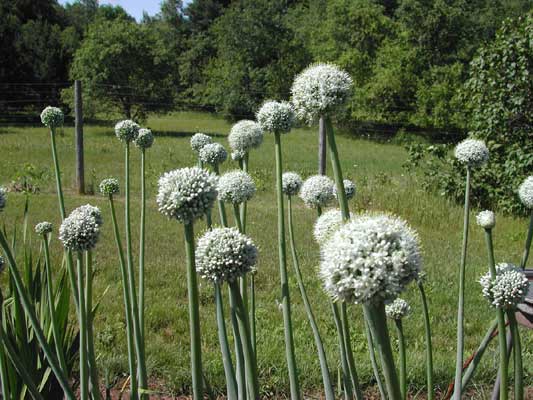 GROWING
and SAVING ONION SEED -- Onion seed is fairly easy to grow if you’ve grown
onions from open pollinated seed. Onions grown from hybrid seed generally won’t
come true to the parent or may not set seed at all (doesn’t mean you couldn’t
try however). All seed producing onions will cross so you’ll want to plant only
one variety at a time for seed unless you purposely want them to cross. In the
fall when you harvest your onions pick out 9 or more of what you consider to be
the best bulbs for your purpose. Replant them just below soil level about 12
inches apart. Mulch them and let them settle in for the winter. In the spring
they will grow and send up seed stalks topped by beautiful allium flower balls,
which in good years will result in a nice harvest of seed. When most of the
little individual seed husks start to dry and you notice them opening up in
preparation to dropping their seed, cut the seed ball into a shallow container
or paper bag and bring them inside or in a dry protected area to finish drying.
Mine are often still rather green so need some time to finish maturing and
drying. Even if the weather is nice and dry outside you’ll want to harvest the
heads before all of the seed husks are ready to prevent the plant self seeding
all over the ground on it’s own which is what it wants to do. I put them in a
paper bag or in a open container of some kind to finish drying. GROWING
and SAVING ONION SEED -- Onion seed is fairly easy to grow if you’ve grown
onions from open pollinated seed. Onions grown from hybrid seed generally won’t
come true to the parent or may not set seed at all (doesn’t mean you couldn’t
try however). All seed producing onions will cross so you’ll want to plant only
one variety at a time for seed unless you purposely want them to cross. In the
fall when you harvest your onions pick out 9 or more of what you consider to be
the best bulbs for your purpose. Replant them just below soil level about 12
inches apart. Mulch them and let them settle in for the winter. In the spring
they will grow and send up seed stalks topped by beautiful allium flower balls,
which in good years will result in a nice harvest of seed. When most of the
little individual seed husks start to dry and you notice them opening up in
preparation to dropping their seed, cut the seed ball into a shallow container
or paper bag and bring them inside or in a dry protected area to finish drying.
Mine are often still rather green so need some time to finish maturing and
drying. Even if the weather is nice and dry outside you’ll want to harvest the
heads before all of the seed husks are ready to prevent the plant self seeding
all over the ground on it’s own which is what it wants to do. I put them in a
paper bag or in a open container of some kind to finish drying.
When the seed heads are well dried and rattly and the seed is falling out rub
the heads between your hands (leather gloves sometimes does better than bare
hands) to finish separating the seed. Gently winnow off whatever trash you can
with a low fan or wind. Since it’s just for your own use it doesn’t matter if it
isn’t real clean and you risk losing seed if you get over enthusiastic with your
winnowing. You can also screen them seed with various sizes of screen to
separate out the smallest and largest trash. As with all seed, store in a cool,
dry, dark area for planting next spring, and for several years after if you have
enough seed. That's the nice thing about growing your own seed. If all goes
well, you'll end up with handfuls of seed instead of just a small packet.
OTHER ALLIUMS -- In addition to seed onions and potato onions there are leeks
and bunching onions and shallots and garlic. And if all else fails (which it
never has nor do I expect it will) there are always chives. Not much can stop a
chive. I stopped growing them in the garden decades ago and they are happily
growing wild all over instead -- early, late, in-between, and in all kinds of
soil. If there is anything green growing outside, there are chives to be had.
And one can always head to the woods to harvest some highly flavored wild leeks.
Meals need never be too mild or too boring once you become friends with the
Alliums.
* * * * * * * *
Copyright © by Susan Robishaw
|
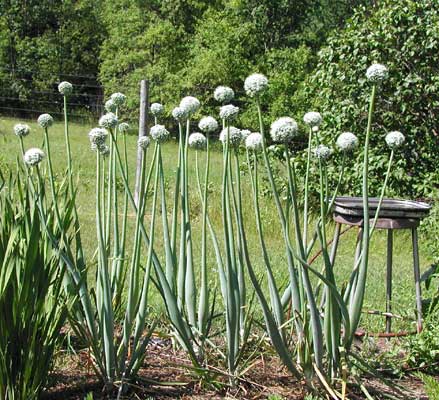


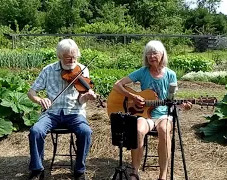
 We eat quite a lot of onions - small ones in luncheon salads, larger
ones in a variety of dinner dishes, tiny ones to save and plant next
year as onion sets, any size diced up with sweet peppers and fermented
into a delicious relish. My seed is an open-pollinated mix that I've
been growing and saving for decades, aiming for that sweet spot of
medium size that is just right for one meal. And some years I get a lot
that size, some years more smalls, and some years more large. My onions
are very independent.
We eat quite a lot of onions - small ones in luncheon salads, larger
ones in a variety of dinner dishes, tiny ones to save and plant next
year as onion sets, any size diced up with sweet peppers and fermented
into a delicious relish. My seed is an open-pollinated mix that I've
been growing and saving for decades, aiming for that sweet spot of
medium size that is just right for one meal. And some years I get a lot
that size, some years more smalls, and some years more large. My onions
are very independent.  They
simply grow and when the weather has settled some outside they’re ready to go.
Because we often get early spring dips into the teens I’ve learned to be patient
and not set the onions out too early, usually end of May/first of June. Once
they’re established they’re quite hardy but new transplants are somewhat tender,
and hard to cover. I like to wait for cloudy days to set them out since they
usually don’t get any extra protection while settling in. A kitchen fork makes a
good tool to loosen the plants from the flat and the roots from each other.
Sometimes I hoe a trench and set the plants in about 5” apart, pulling the dirt
back around them as I go. Sometimes I use my long dibble to set the spacing and
make small holes, using my fingers or fork to make a larger hole when needed to
put the little plant in. Then a good watering if no rain is imminent and they’re
done.
They
simply grow and when the weather has settled some outside they’re ready to go.
Because we often get early spring dips into the teens I’ve learned to be patient
and not set the onions out too early, usually end of May/first of June. Once
they’re established they’re quite hardy but new transplants are somewhat tender,
and hard to cover. I like to wait for cloudy days to set them out since they
usually don’t get any extra protection while settling in. A kitchen fork makes a
good tool to loosen the plants from the flat and the roots from each other.
Sometimes I hoe a trench and set the plants in about 5” apart, pulling the dirt
back around them as I go. Sometimes I use my long dibble to set the spacing and
make small holes, using my fingers or fork to make a larger hole when needed to
put the little plant in. Then a good watering if no rain is imminent and they’re
done.  ONION
SETS -- Onion sets are readily available in the spring in our area -- paper bags
of usually yellow sets of variable quality and unknown parentage and source, but
probably all the same. If you sort through and toss half, the rest will make a
pretty good crop of reasonable storage onions. You can often get better quality
ones from a good seed company if you remember to order them early enough.
They’re easy to plant, just push them in where you want them to grow, root side
down. But I don’t like to be so limited, I want to know where my plants come
from, who they are, and I want diversity. Plus I like to do my own. So, in
addition to all the other onion methods I use, I like to grow my own sets. It’s
not hard if you plant them at the right time for the weather conditions that
year. The weather is a pretty big variable but if all goes well you can have
some really nice and easy to plant sets, then other years not so. So I still
depend on my seed crop, but sets are easier.
ONION
SETS -- Onion sets are readily available in the spring in our area -- paper bags
of usually yellow sets of variable quality and unknown parentage and source, but
probably all the same. If you sort through and toss half, the rest will make a
pretty good crop of reasonable storage onions. You can often get better quality
ones from a good seed company if you remember to order them early enough.
They’re easy to plant, just push them in where you want them to grow, root side
down. But I don’t like to be so limited, I want to know where my plants come
from, who they are, and I want diversity. Plus I like to do my own. So, in
addition to all the other onion methods I use, I like to grow my own sets. It’s
not hard if you plant them at the right time for the weather conditions that
year. The weather is a pretty big variable but if all goes well you can have
some really nice and easy to plant sets, then other years not so. So I still
depend on my seed crop, but sets are easier. I
harvest on a sunny day when the soil isn’t too wet. Pull the onions and lay them
out along the plot in the sun for initial drying and for sorting. Then move them
out to a convenient spot in the shade for curing. My favorite is on the plywood
floor of our woodshed (in summer it's also a storage shed so space is limited).
Most years late summer/early fall is nice enough weather that this works fine. I
might also spread the onions out on the lawn somewhere dry and out of the way,
taking them under cover at night (when damp settles in or frost threatens),
spreading them out again when it’s nice. Basically you want an airy, dry spot
out of hot sun for several or more weeks.
I
harvest on a sunny day when the soil isn’t too wet. Pull the onions and lay them
out along the plot in the sun for initial drying and for sorting. Then move them
out to a convenient spot in the shade for curing. My favorite is on the plywood
floor of our woodshed (in summer it's also a storage shed so space is limited).
Most years late summer/early fall is nice enough weather that this works fine. I
might also spread the onions out on the lawn somewhere dry and out of the way,
taking them under cover at night (when damp settles in or frost threatens),
spreading them out again when it’s nice. Basically you want an airy, dry spot
out of hot sun for several or more weeks.  After
some time of this in and out the tops are all dried and mostly crumpled off, the
roots are dried and easy to break or snip off, the skins are nice and crinkly
dry. Sometimes I just rub off whatever tops are left and whatever roots want to
go and not worry about the rest. Often I sit down with shears and snip off the
dried tops and roots, gently rubbing off excess skins and setting them happily
in wooden crates or half-bushel baskets. It’s a pleasant task and one I enjoy.
Any thicknecks or bulbs not cured yet are put in a separate basket or bucket to
be eaten first. Though those thicknecks will last quite awhile, stored in a
bucket in the rootcellar. So if you have a year of many thicknecks (some years
are like that) don't fret too much. Save your best keepers for later and enjoy
the thicknecks earlier.
After
some time of this in and out the tops are all dried and mostly crumpled off, the
roots are dried and easy to break or snip off, the skins are nice and crinkly
dry. Sometimes I just rub off whatever tops are left and whatever roots want to
go and not worry about the rest. Often I sit down with shears and snip off the
dried tops and roots, gently rubbing off excess skins and setting them happily
in wooden crates or half-bushel baskets. It’s a pleasant task and one I enjoy.
Any thicknecks or bulbs not cured yet are put in a separate basket or bucket to
be eaten first. Though those thicknecks will last quite awhile, stored in a
bucket in the rootcellar. So if you have a year of many thicknecks (some years
are like that) don't fret too much. Save your best keepers for later and enjoy
the thicknecks earlier. GROWING
and SAVING ONION SEED -- Onion seed is fairly easy to grow if you’ve grown
onions from open pollinated seed. Onions grown from hybrid seed generally won’t
come true to the parent or may not set seed at all (doesn’t mean you couldn’t
try however). All seed producing onions will cross so you’ll want to plant only
one variety at a time for seed unless you purposely want them to cross. In the
fall when you harvest your onions pick out 9 or more of what you consider to be
the best bulbs for your purpose. Replant them just below soil level about 12
inches apart. Mulch them and let them settle in for the winter. In the spring
they will grow and send up seed stalks topped by beautiful allium flower balls,
which in good years will result in a nice harvest of seed. When most of the
little individual seed husks start to dry and you notice them opening up in
preparation to dropping their seed, cut the seed ball into a shallow container
or paper bag and bring them inside or in a dry protected area to finish drying.
Mine are often still rather green so need some time to finish maturing and
drying. Even if the weather is nice and dry outside you’ll want to harvest the
heads before all of the seed husks are ready to prevent the plant self seeding
all over the ground on it’s own which is what it wants to do. I put them in a
paper bag or in a open container of some kind to finish drying.
GROWING
and SAVING ONION SEED -- Onion seed is fairly easy to grow if you’ve grown
onions from open pollinated seed. Onions grown from hybrid seed generally won’t
come true to the parent or may not set seed at all (doesn’t mean you couldn’t
try however). All seed producing onions will cross so you’ll want to plant only
one variety at a time for seed unless you purposely want them to cross. In the
fall when you harvest your onions pick out 9 or more of what you consider to be
the best bulbs for your purpose. Replant them just below soil level about 12
inches apart. Mulch them and let them settle in for the winter. In the spring
they will grow and send up seed stalks topped by beautiful allium flower balls,
which in good years will result in a nice harvest of seed. When most of the
little individual seed husks start to dry and you notice them opening up in
preparation to dropping their seed, cut the seed ball into a shallow container
or paper bag and bring them inside or in a dry protected area to finish drying.
Mine are often still rather green so need some time to finish maturing and
drying. Even if the weather is nice and dry outside you’ll want to harvest the
heads before all of the seed husks are ready to prevent the plant self seeding
all over the ground on it’s own which is what it wants to do. I put them in a
paper bag or in a open container of some kind to finish drying.